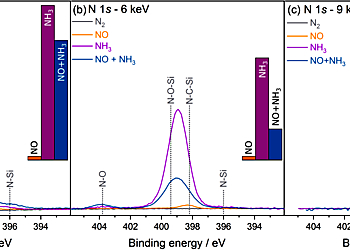Effects of Nitridation on SiC/SiO2 Structures Studied by Hard X-ray Photoelectron Spectroscopy
Result of the Month
In this work device-relevant stacks of SiC and SiO2 are investigated using energy-dependent X-ray photoelectron spectroscopy. SiC is an important wide band gap material for a range of power electronic applications. The main challenge that the semiconductor industry is tackling now is the quality of the interface between SiC and its native dielectric SiO2, which currently limits further improvement of device performance. Nitridation at high temperatures can improve the interface quality significantly, but the understanding of underlying chemical processes is limited. In this study the HAXPES Lab system was used to initially explore SiC/SiO2 stacks treated with four different nitrogen atmospheres, including N2, NO, NH3, and NO+NH3. The crucial incorporation of nitrogen at the interface, which can passivate defects and ultimately improve device behavior, is challenging to probe as e.g. in the very effective NO anneal only a minute amount of nitrogen is incorporated, limited to the interface region only. Although cross sections for the N 1s core states in HAXPES are comparatively low, the stability of the HAXPES Lab system enabled long duration acquisition to gather the core state spectra. Based on the initial results from the laboratory system, the samples were investigated at beamline I09 at Diamond Light Source, where they were probed using two further hard X-ray energies (4 and 6 keV). By combining results from both laboratory and synchrotron HAXPES systems and contrasting these with previous laboratory-based SXPS depth profiling results a complete picture of the depth distribution and chemical states of nitrogen is presented. This provides crucial insights into the chemical reactions taking place at the SiC/SiO2 interface as well as in the bulk layers enabling further device improvement and development.
Authors
Judith Veronika Berens1, Sebastian Bichelmaier1, Nathalie K Fernando2, Pardeep Kumar Thakur3, Tien-Lin Lee3, Manfred Mascheck4, Tomas Wiell5, Susanna K Eriksson5, J. Matthias Kahk6, Johannes Lischner6, Manesh Mistry7, Thomas Aichinger8, Gregor Pobegen1 and Anna Regoutz2
Institutes
1) Kompetenzzentrum für Automobil- und Industrieelektronik GmbH, Europastraße 8, 9524 Villach-St. Magdalen, Austria.
2) Department of Chemistry, University College London, 20 Gordon Street, London,WC1H 0AJ, United Kingdom.
3) Diamond Light Source, Harwell Science and Innovation Campus, Didcot, OX110DE, United Kingdom.
4) Scienta Omicron GmbH, Limburger Strasse 75, 65232 Taunusstein, Germany.
5) Scienta Omicron AB, P.O. Box 15120, 750 15 Uppsala, Sweden.
6) Department of Materials, Imperial College London, South Kensington, London SW7 2AZ, United Kingdom and the Thomas Young Centre for Theory and Simulation of Materials.
7) Department of Physics and Astronomy, University College London, Gower Street, London WC1E 6BT, United Kingdom.
8) Infineon Technologies Austria AG, Siemenstraße 2, 9500 Villach, Austria.
Name and email of corresponding author
Anna Regoutz, a.regoutz@ucl.ac.uk
Publication(s)
Judith Veronika Berens, Sebastian Bichelmaier, Nathalie K Fernando, Pardeep Kumar Thakur, Tien-Lin Lee, Manfred Mascheck, Tomas Wiell, Susanna K Eriksson, J. Matthias Kahk, Johannes Lischner, Manesh Mistry, Thomas Aichinger, Gregor Pobegen and Anna Regoutz, Effects of nitridation on SiC/SiO2 structures studied by hard X-ray photoelectron spectroscopy, JPhys. Energy, in press, 2020. https://doi.org/10.1088/2515-7655/ab8c5e
URL of Journal(s)

